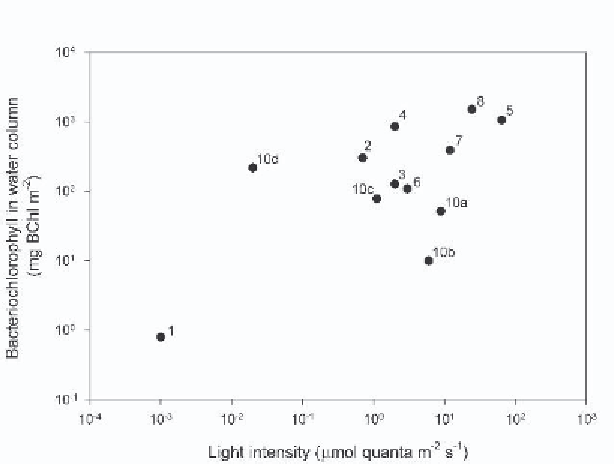Environmental Engineering Reference
In-Depth Information
Figure 3.
Relation between bacteriochlorophyll amount in the water column and light intensity
reaching the bacterial plate for different anoxygenic phototrophic communities.
1
Black Sea [45];
2
Big Soda Lake [10];
3
Mary Lake [57];
4
Knaack Lake [58];
5
Mahoney Lake [50];
6
Mirror
Lake [57];
7
Rose Lake [57];
8
Lake Ciso [22, 47];
10a
Banyoles, BChl
a
plate (August);
10b
Banyoles, BChl
a
plate (May);
10c
Banyoles, BChl
e
plate (August);
10d
Banyoles, BChl
e
plate
(May) [7].
Field and laboratory data can be used to infer the significance of anoxygenic
photosynthesis for sulfide turnover in the Black Sea chemocline. Based on
the vertical profiles of sulfide concentrations determined at two stations in the
western basin of the Black Sea [45], and employing a coefficient for turbulent
diffusivity of 1.0·10
−
5
m
2
·s
−
1
(at 100 m depth) [38], the sulfide flux into the
layer of green sulfur bacteria amounts to 0.37 - 0.53 mmol m
−
2
d
−
1
. This value
is very similar to that estimated earlier for a depth of 150 m (0.421 mmol m
−
2
d
−
1
) [38]. The results of modeling the upward fluxes of sulfide suggest that
sulfide is actually consumed within the anoxic zone between the chemocline
and 150 m depth, but not within the chemocline [38]. Most likely molecular
oxygen enters the anoxic zone by massive lateral injections of oxygen-enriched
Mediterranean waters through the Bosporus plume, and leads to the formation
and sedimentation of particulate MnO
2
in the chemocline which in turn serves
as the oxidant of
70% of the sulfide diffusing upwards [39]. Together with
molecular diffusion of O
2
from upper water layers (accounting for
∼
10% of
the sulfide oxidation) [38], the fluxes of molecular oxygen thus are sufficient to
∼

